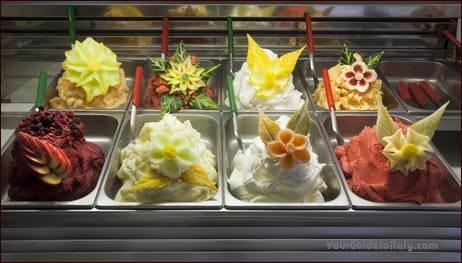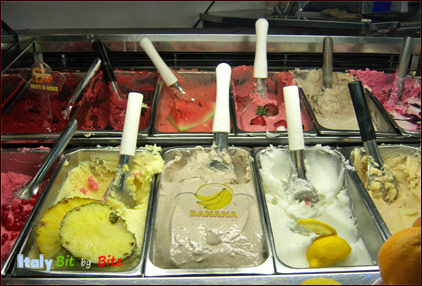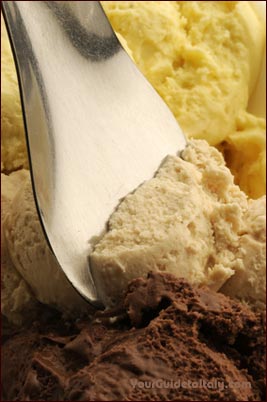.
.
.
5. Next thing to check is how the gelato is being served. Traditional gelato is not served with an ice cream scoop or disher. Instead a typical gelato spatula is being used, which allows to 'work' the gelato before pressing it on the cone or into the cup (coppetta). That is because artisan gelato is generally served at a temperature of -15°C or +5°F whereas the serving temperature of regular ice cream is usually around -20°C or -4°F. In very touristy spot you may see 'gelato' served with an ice cream disher, but that is usually a sign that the 'gelato' has not really much in common with genuine gelato, because genuine gelato is less solid than regular ice cream and doesn't lend itself well to being served with an ice cream disher.
6. For the same reason, when ordering gelato you will not be asked how many gelato scoops you'd like, but just what size of cone or cup you wish. You can then choose to have just one or several different flavors, independently of the size of the cup or cone you have chosen. If you take two different flavors in a small cup you will just get less of each. You can also ask to have more of one flavor and just a tidbit of another, as portions are not standardized gelato scoops, but adaptable to your choice with the spatula. In the smallest cup you can usually have one or two different flavors, in the medium-sized cup, one to three and in the larger sized ones usually up to four. Even though this way of serving is typical Italian and may not be so common in very touristy spots, it is worth seeking for a traditional gelateria off the main street or piazza which serves gelato in the traditional way. Chances are high that your gelato will also taste better!
7. Quality gelato is made without preservatives, as it is not usually intended to be stored for long. It can be stored for a longer period of time, but the best gelaterie prefer to make fresh gelato on a daily or almost hourly basis. Top quality gelaterie actually only serve freshly made gelato because they know that after a couple of hours ice cristals are being formed within the gelato which changes the intensity of the flavor. So, a good sign that the gelato is really freshly 'home-made' is when you see that the different flavors are being 'refilled' in small batches, made on an hourly basis.
8. Personally, when I see that the presentation is really overdone, with huge piles of gelato and extravagant fresh fruit decoration, it tends to make me a little suspicious. As I already said, quality sells itself without having to be boosted. An extremely visual display may indicate that this gelateria is relying more on walkers-by than on a loyal clientèle, which may not be a good sign.
1. A good gelateria make their gelato on-site using fresh, natural and seasonal products. So it will usually have a sign saying: produzione propria (home-made, on-site production), gelato artigianale (artisan gelato), prodotto alla vecchia maniera (produced the old-fashioned way), gelato di una volta (old-fashioned gelato).
2. As we mentioned in the first point, a quality gelateria only works with fresh, natural and seasonal ingredients. This is especially true for the fruit-based gelatos, but also for many cream-based flavors. When all types of fruit flavors are available all year round it is usually a sign that the gelateria is working from semi-processed ingredients or artificial flavors. Move on!
3. Gelaterie in touristy spots can have up to 60 or 80 different flavors (gusti). Such a huge amount of different flavors is often (not always) a sign that the gelateria works from semi-finished gelato ingredients, which allows to create many different flavors from the same base. While it may be fun to walk through these gelaterie and even order a crazy combination of flavors, if you are looking for the genuine artisan gelato made in the old-fashioned way, you might prefer picking a less magnanimous gelateria with 'only' between 10 and 15 different flavors.
4. Likewise, avoid gelaterie displaying very flashy and colorful gelato flavors. In fact, as no artificial colors are being used in quality gelato, the shades of colors are much duller than in industrial ice cream: a light-colored kaki for pistacchio (no flashy green), greyish for banana and fig, and soft rose for strawberry. Only egg-based, chocolate flavors and the reddish fruit gelato have deeper colors.













